Building a One Product Shopify Store: How to Go Big With a Single SKU
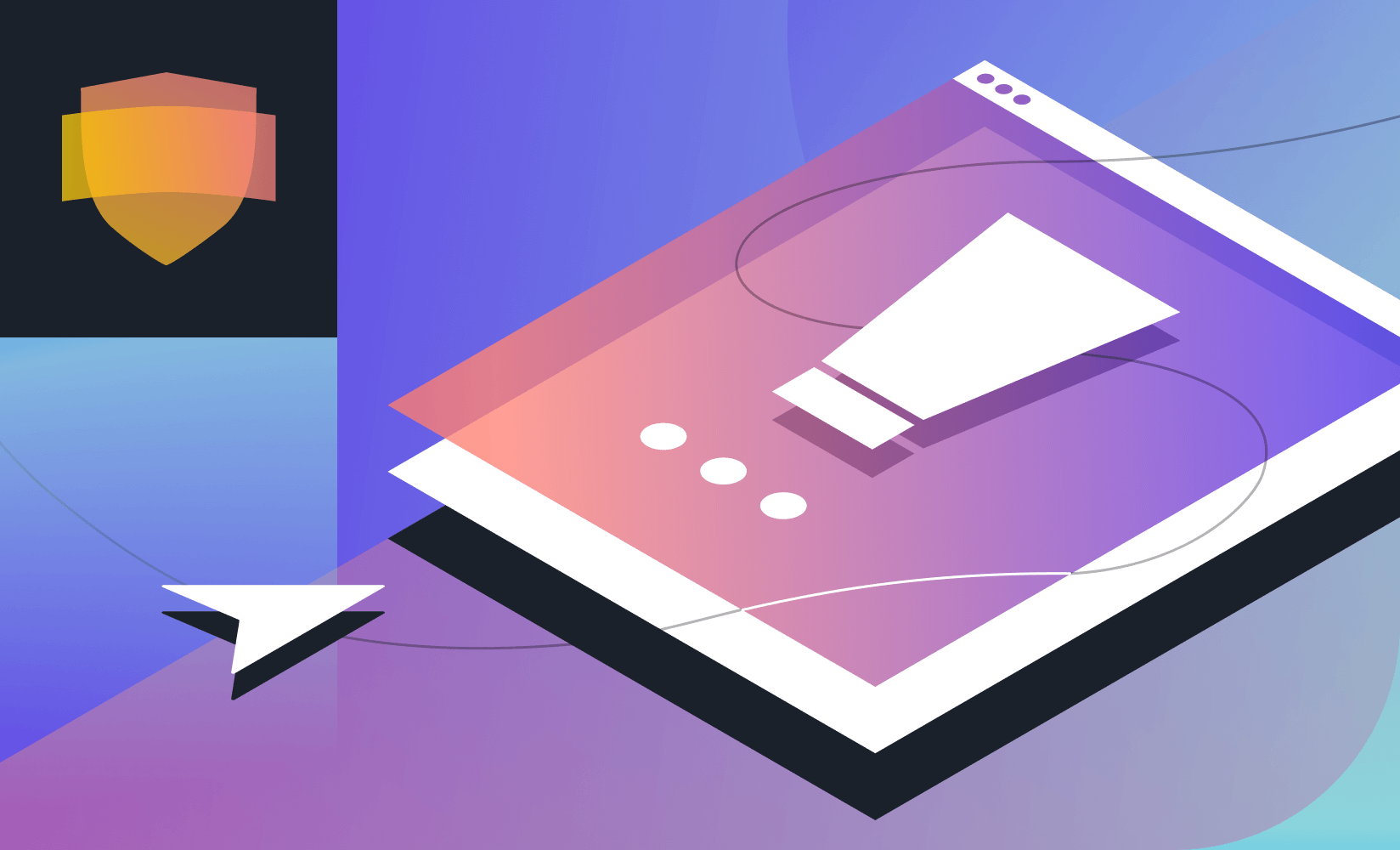
When Crocs launched in 2002, they decided to do one thing and do it well: create and distribute their signature clogs—unique, comfortable, and ideal for a long day of work.
Crocs’ three founders were sailing across the Caribbean when they decided they wanted to make the perfect shoes for boating. These had to be light, waterproof, sturdy, and comfortable.
They did the research, created their product, secured exclusive rights to their foam technology, then began to distribute their product.
They received feedback from their customers, used the product themselves, and reiterated their message persistently until their comfortable shoes gained appeal with nurses, kitchen workers, and other professionals who needed to be on their feet all day.
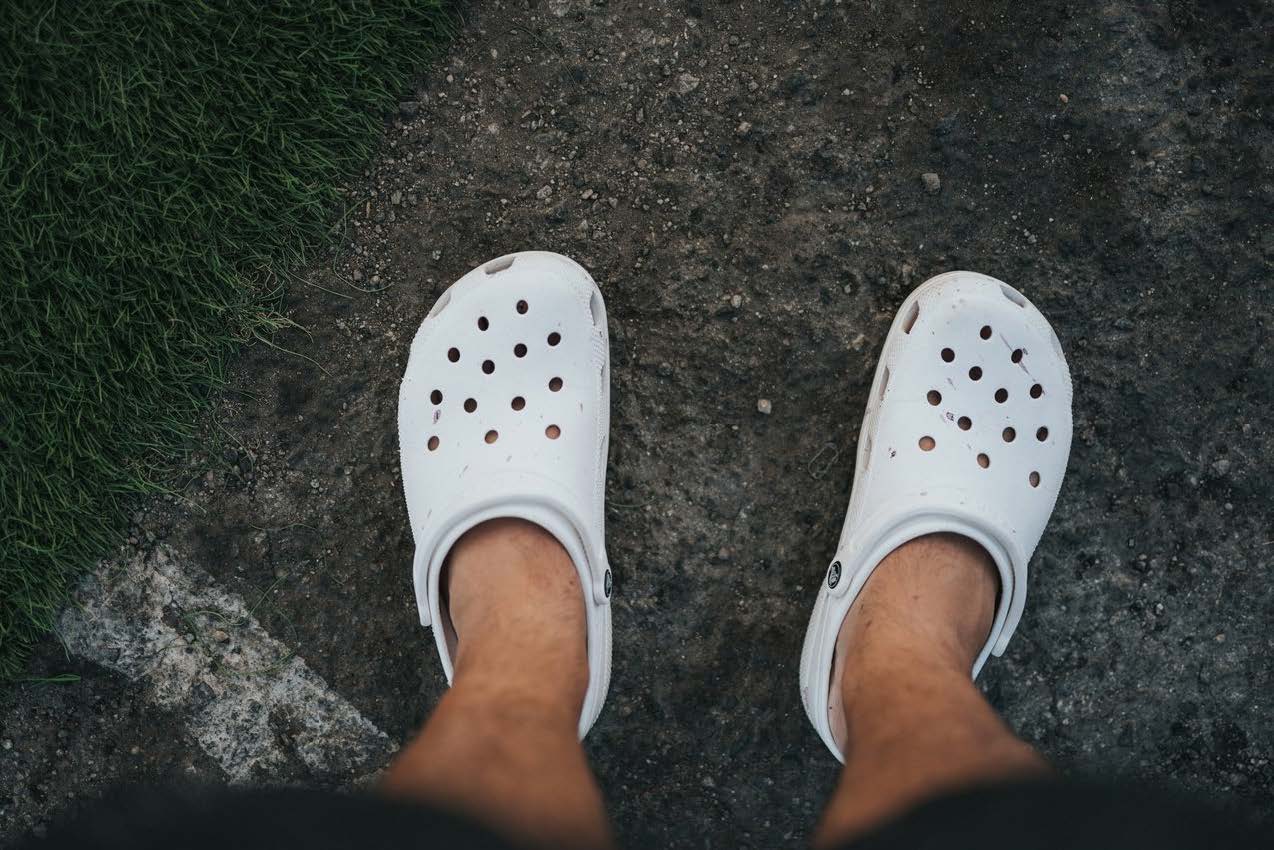
To this day, despite offering different shoes in multiple colors, Crocs still owes a large part of their success to their best-selling iconic clogs.
The clog company built their empire on a single product because it allowed them to focus on creating a product their target market loved.
Single product stores are great for entrepreneurs who have an invention they want to distribute or an idea they want to share with a specific target audience.
Like Crocs, if you focus on your one product and elevate it to the point where people can’t live without it, your single product Shopify store will generate the traffic and traction you need to achieve success.
In this post, we’ll cover:
#cta-visual-pb#<cta-title>Create the perfect Shopify store<cta-title>Take your store to the next level with Shogun Page Builder.Start building for free
What is a one product Shopify store?
A one product Shopify store, as the name suggests, is an ecommerce site built around a single product.
Inventors and entrepreneurs create single product websites to showcase what they’re selling without having to manage multiple products.
That way, they can focus on producing one amazing product instead of spreading themselves thin trying to sell multiple products and manage a massive ecommerce website with a small team.
What types of products work best with a one product store?
Any kind of product can work well in a one product store. However, you should follow a few guidelines to get started.
- Your product must outshine the alternatives. If you only offer one thing, it should outshine your competitors—your brand isn’t selling variety, so it needs to sell quality.
- Aim for something with healthy margins. That single product should be able to sustain your business, so you don’t want something with low margins (imagine only selling black pens or only selling colorful paperclips).
- Create something unique. If you can create a unique product as Crocs did with their shoes, you widen the moat between your single product and copycats. This also increases your competitive advantage.
Should you build a one product Shopify store?
Now that you know what a one product store is, you need to decide if building one is best for you.
We’ve compiled some pros, cons, and comparisons to help you make that decision.
5 pros of selling one product
Selling one product provides many advantages. Here are some that might be relevant to you:
- You can focus on your product. Rather than feeling pressured to have 10 great products, you only need to focus on one.
- You can build for a specific market. Your ecommerce goal will always be to engage your ideal customer—the kind who will buy your product, share it with their friends, and then buy it again for themselves or as a gift. It’s easier to identify your target when you only sell one thing (no matter how niche).
- Your marketing is simpler. Because you only have one product and are talking to one ideal customer type, it’s easier to optimize social media pages, create social media posts, and write website copy that aligns with their interests and beliefs.
- You don’t need to hire a large team. Single product stores don’t require much maintenance, so you really only need a handful of people to answer customer questions, do your marketing, manage your website, and stay on top of your production line.
- They’re great for branding. Brand recall is stronger when you have that one product people will remember you for.
If you want an online store that’s easy to manage and market, a one product shop is your best bet.
3 cons of selling one product
One product stores aren’t for everyone. Here are some disadvantages to keep in mind if you’re still a little on the fence:
- You can’t cross-sell. You only have one product, so there’s little to no opportunity for cross-selling, which means lower customer lifetime value (LTV). For example, if you sell an innovative travel bag, you won’t be able to suggest your customers also buy a bag organizer or a passport holder because you only have the one bag on your site.
- You don’t have a lot of marketing choices. Because you’re marketing one product, you’ll have to get creative with your marketing material. It’s easy to get repetitive with single product stores.
- You’ll earn fewer returning customers. Unless you’re selling something perishable or consumable, like deodorant, you’ll have fewer returning customers. If you sell a bag, for instance, you don’t want your customers coming back in a month unless they want to buy another as a gift.
If you’re looking to create a one-stop shop of sorts for your customers, a single product store might not be a good fit for you.
Comparing one product and multiple product stores
Now that we’ve listed the pros and cons of single product stores, let’s get into how they compare with multiple product stores.
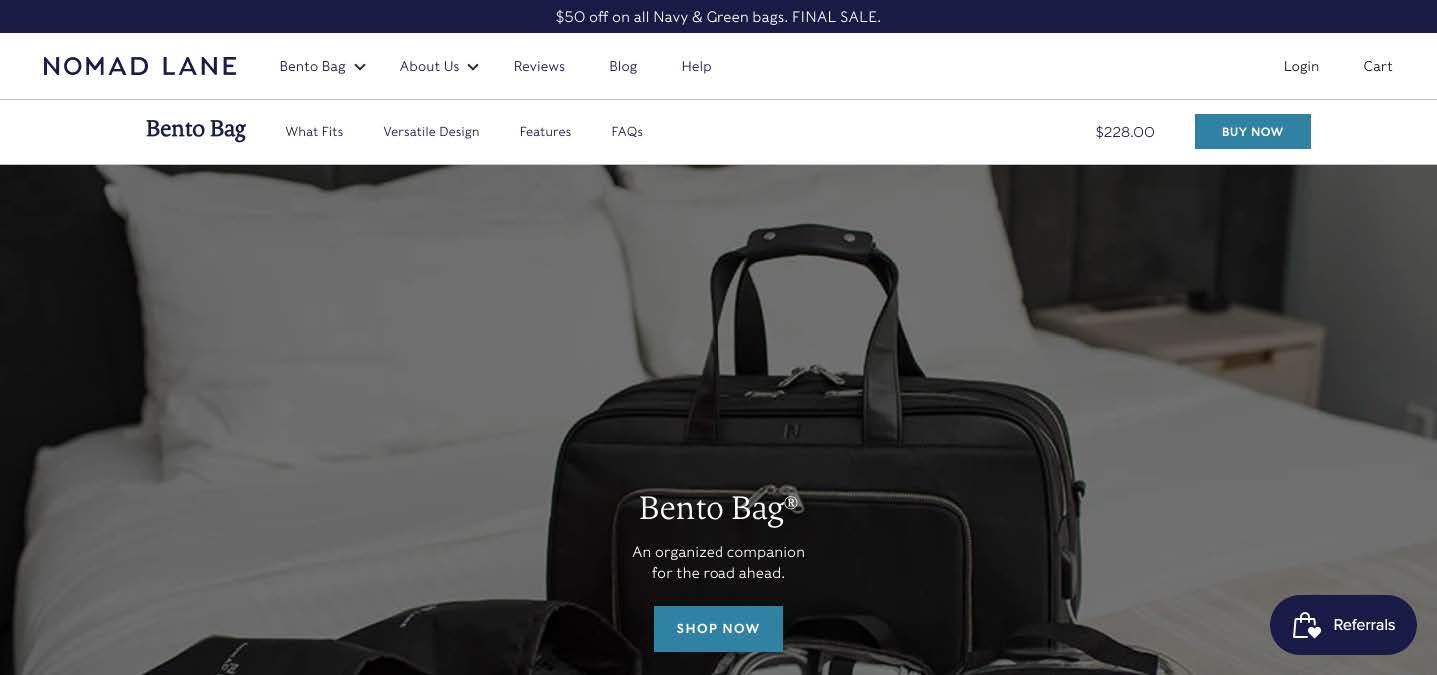
Single product brands have the advantage of being easier to manage, and if you stumble across a winner, you’re gold.
Mitchell Sandridge, for example, built a one product store in the children’s clothing category that earned USD$680K in three months.
He chose a product he could make cool videos out of and tested it as a social media ad.
Soon, because of how simple single-product websites are to manage, he was able to construct a replicable model he could use across different one product stores.
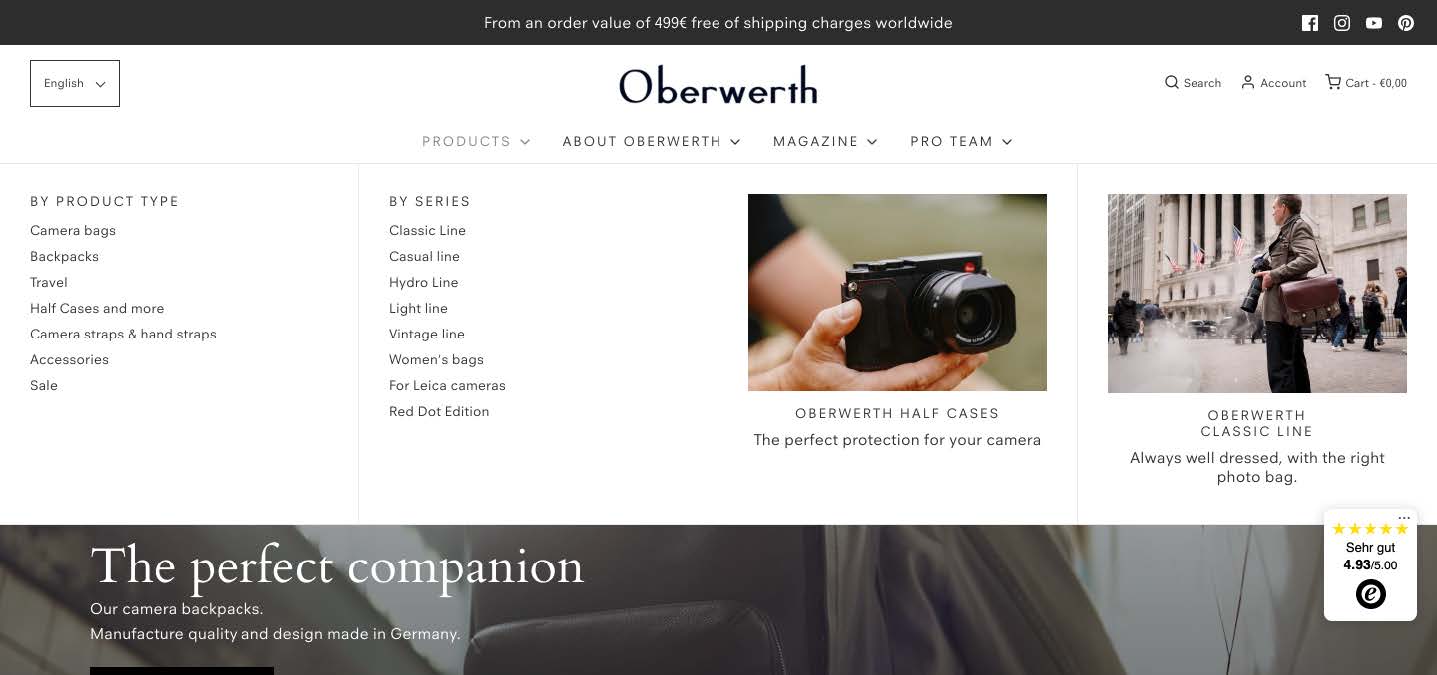
Multiple product companies provide more profit gain opportunities but are harder to handle.
Because multiple product stores have collections of related items, it’s easier to cross-sell to potential customers and earn more sales out of each buyer, which increases LTV.
But having multiple products also means you need to do much more on the backend and have a bigger chance of losing money.
#cta-visual-pb#<cta-title>Build a Shopify store in minutes<cta-title>Showcase exactly what you want with Shogun’s drag-and-drop page editor.Start designing for free
How to start a one product Shopify store
Another advantage of a one product Shopify store is that it’s so easy to build.
You simply have to plan your store, build it quickly with a drag-and-drop builder, and then start marketing.
Step 1: Figure out what you want to sell and how you’ll sell it
You can’t build a one product shop without your product, so first, you need to figure out what you want to sell. To do that, you need to find your target audience and execute your product research.
Find your target audience
The easiest way to determine this is to have a rough idea of who your target audience is.
For example, if your target audience is working moms, you might want to sell something related to kids, productivity, or relaxation.
If your target audience is workout buffs, you’ll want to go for exercise equipment. When you know who you want to appeal to, you can discover the problems they’re having that you want to solve.
Execute your product research
Next is product research.
You need to have an idea of how receptive the locals in your target regions will be toward your product. Look up your product on a search engine—are people noticing it?
Join Facebook groups, check out Pinterest boards, get on Amazon and Kickstarter, and look at the social media profiles of your target audience.
If your product answers a specific need, then you might have a winner.
Decide on your product and how you’ll sell it
Here are some additional questions you can ask yourself when figuring out what your product is going to be:
- Can I see myself using this product?
- Is my product unique enough?
- Can I build an entire brand out of this product?
- Does my product have a chance of going viral if I put it on social media?
- Do I want a lot of repeat customers?
- Do I want to sell internationally?
- How am I going to produce this on a large scale?
- Can I create a story around my product that aligns it with the ideals of my target audience?
After deciding what product you want to sell and who to sell it to, you need to determine where you want to sell—locally, nationally, internationally, or in specific regions.
You also need to find out how you’re going to ship your product and the shipping laws in the regions you plan to sell to.
Step 2: Plan your brand strategy
Your goal is to be memorable and relatable—and you do that with branding.
You only have one product, so you need to get people to associate your product with your company name and remember you.
Nail down your dream customers
Your branding strategy should revolve around your ideal customers because you want to catch their attention and get them to buy.
In step 1, you identified the broad strokes of who your ideal audience is; now, we have to get more specific.
For example, if your target market is working moms, here are some questions you can ask yourself:
- What are their jobs?
- How old are their kids?
- Where do they live?
- What are their interests?
- What are their most pressing concerns?
- How do they identify themselves?
- What social networks do they use?
You need to be as specific as possible and create a buyer persona you can connect with.
Having a single customer in mind when you build your one product website will help you make better decisions and construct a site that speaks to your target audience.
Plan your brand identity and colors
Your brand identity guides your brand’s logo, colors, style, and tone.
For example, you can be “fun and friendly, but not cheesy.” Knowing how you want your customers to see your brand will help you make it relatable and memorable.
A one product store example that chose a minimalist identity is 8000Kicks, which sells hemp shoes.
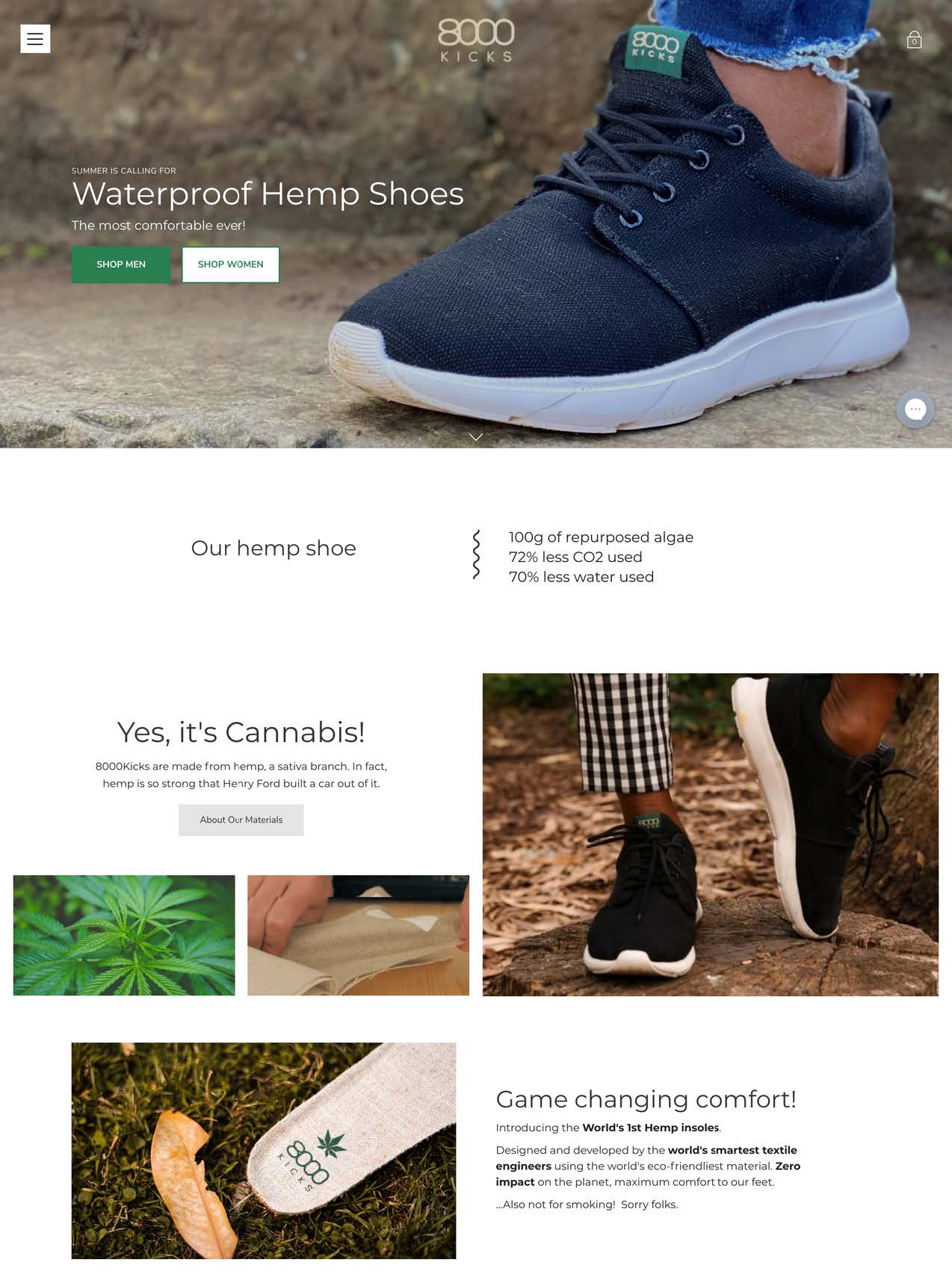
Their logo is their name with a cannabis symbol above it, and they crafted a webpage that features their shoes, explains their benefits, and highlights that the shoe is made out of cannabis and is eco-friendly.
Their logo and homepage capture the attention of cannabis enthusiasts and hikers who want comfortable, waterproof shoes.
Their tone is light and friendly, as you can see from their use of exclamation points and tongue-in-cheek questions in the FAQs (e.g. “Can I smoke the shoe?”).
Make sure your identity points toward your product and resonates with your audience.
Determine your tone
Your tone should reflect how you want people to feel about your brand.
For example, if you sell a high-end watch, you might want to incorporate more formal language on your website. But if you’re targeting kids or teenagers, you can write more fun and exciting website copy.
PillowPup does this brilliantly. You send them a photo of your furry friend, and they make a pillow out of it in the shape of your dog.
Their target market is people who have dogs and who like cute souvenirs, and their tone resonates with that audience: PillowPup is a cute name, their webpage has lots of hearts and photos of cute dogs and pillows on it, and they make great use of emojis and icons.
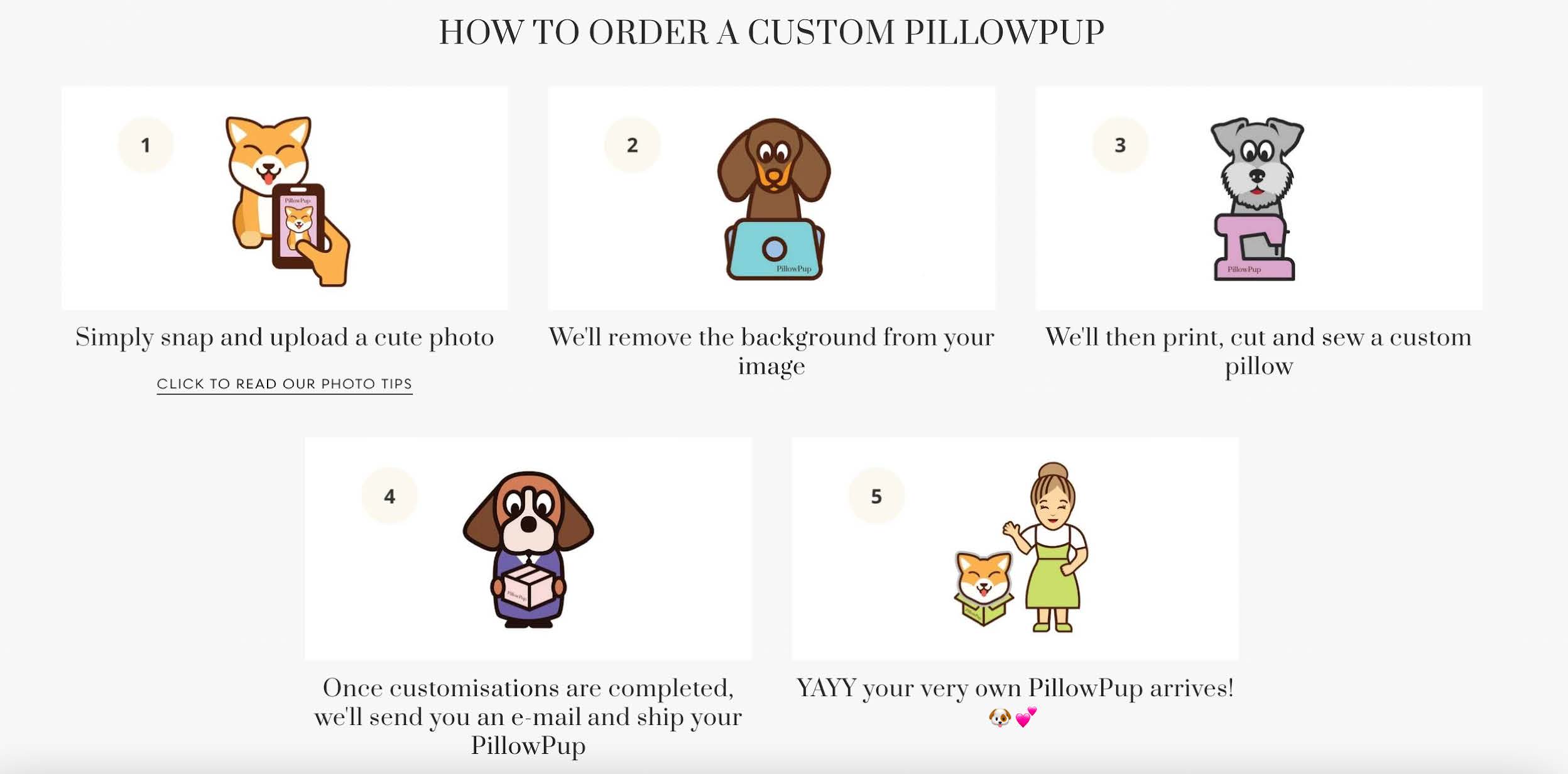
Your tone guides more than your website copy.
If you decide to launch a blog, send emails, or create social posts down the line, your tone should direct how you write to connect with your audience.
Step 3: Build your store
Once you’ve dealt with all the backend tasks, it’s time to design and build the store your visitors and customers will see.
Here’s how you can make a one product website:
- Select the right Shopify theme. Shopify is the best ecommerce platform for single-product stores, and there are tons of Shopify templates for one product websites. Select a theme that meets your product and branding needs. Tip: Take a look at the different themes your favorite Shopify stores use for inspiration.
- Customize your homepage with your branding. Customize your homepage to reflect your brand. Upload your logo, choose appropriate colors and photos, and insert your website copy that explains what problem you’re trying to solve.
- Build your product page. Construct your product page on Shopify with the product name, possible variations field, quantity field, description, price, and photos. Then, go into the Shogun Page Builder to customize it.
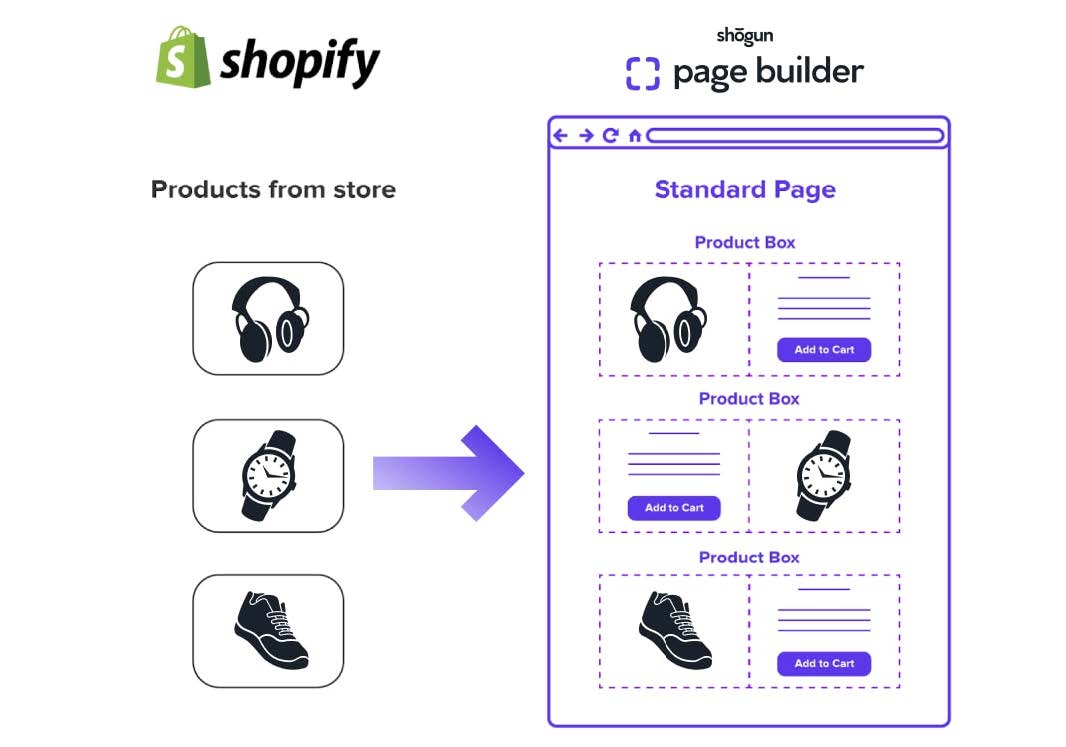
- Set up a post-purchase sequence. Get more out of your customers by giving them post-purchase offers like discounts or referral codes.
Your single product store should have, at minimum, five pages: your homepage, a product page, a checkout page, a contact us page, and your shipping and return policy.
Your homepage should showcase your product and briefly explain your company’s mission (e.g., a more sustainable fashion industry). You can create a one-page website that has different sections visitors can scroll to and include some company history and reviews.
Your product page should go into greater depth about what problem your product seeks to solve and have ecommerce features that allow customers to verify you. Don’t forget to include reviews as social proof here as well.
Your checkout page should be simple and laser-focused on getting consumers to complete a purchase. Make the buying process as quick and easy as possible by allowing guest and one-click checkouts.
Your contact us page should give your customers an easy way to reach you. Consider including a contact form, email address, and live chat option.
Finally, your shipping and return policy should detail how you send out items, what consumers should expect, and how you handle returns.
As you grow, you can also consider building out your website further. For example, you can have a page of customer case studies and testimonials you can refer to or a blog where you share relevant insights.
Step 4: Start marketing
Congrats! You’ve set up your single product page on Shopify. Now you can turn to your single product marketing strategy.
Begin with social media marketing. Create business profiles on your chosen platforms, design organic content, and place your ads.
Make sure your ad copy and photo or video are both compelling so your audience doesn’t just scroll past your ad without a second thought.
You can also try your hand at influencer marketing on social media. After all, 96% of consumers in the U.S. and U.K. engage with influencers they follow on social media.
Some brands use big, celebrity-status influencers to market their product, while others ask their customers to spread the word using affiliate marketing . Once you earn loyal customers, you can ask them to share your product with their followers to reach even more people.
Every time you gain a customer, make sure you get their email address.
Doing so will allow you to put your customers on your email marketing list so you can alert them whenever you have a sale or if you decide to introduce a new product.
The goal of your marketing is to drive your potential customers to visit your store. Your homepage should tell them exactly what you have to offer so they’re more compelled to complete a purchase.
3 successful one product Shopify stores to inspire you
Bokksu, ReduxBuds, and Aurora are three of the best one product Shopify stores out there.
They have all the key components of a successful one product Shopify store: a great product, memorable branding, and amazing reviews.
1. Bokksu: Themed monthly Japanese snack boxes
Bokksu is a subscription-based single product store that sends their subscribers snack boxes with Japanese goodies in them.
Every month, they change the theme of their boxes, so their subscribers are always in for a fun surprise.
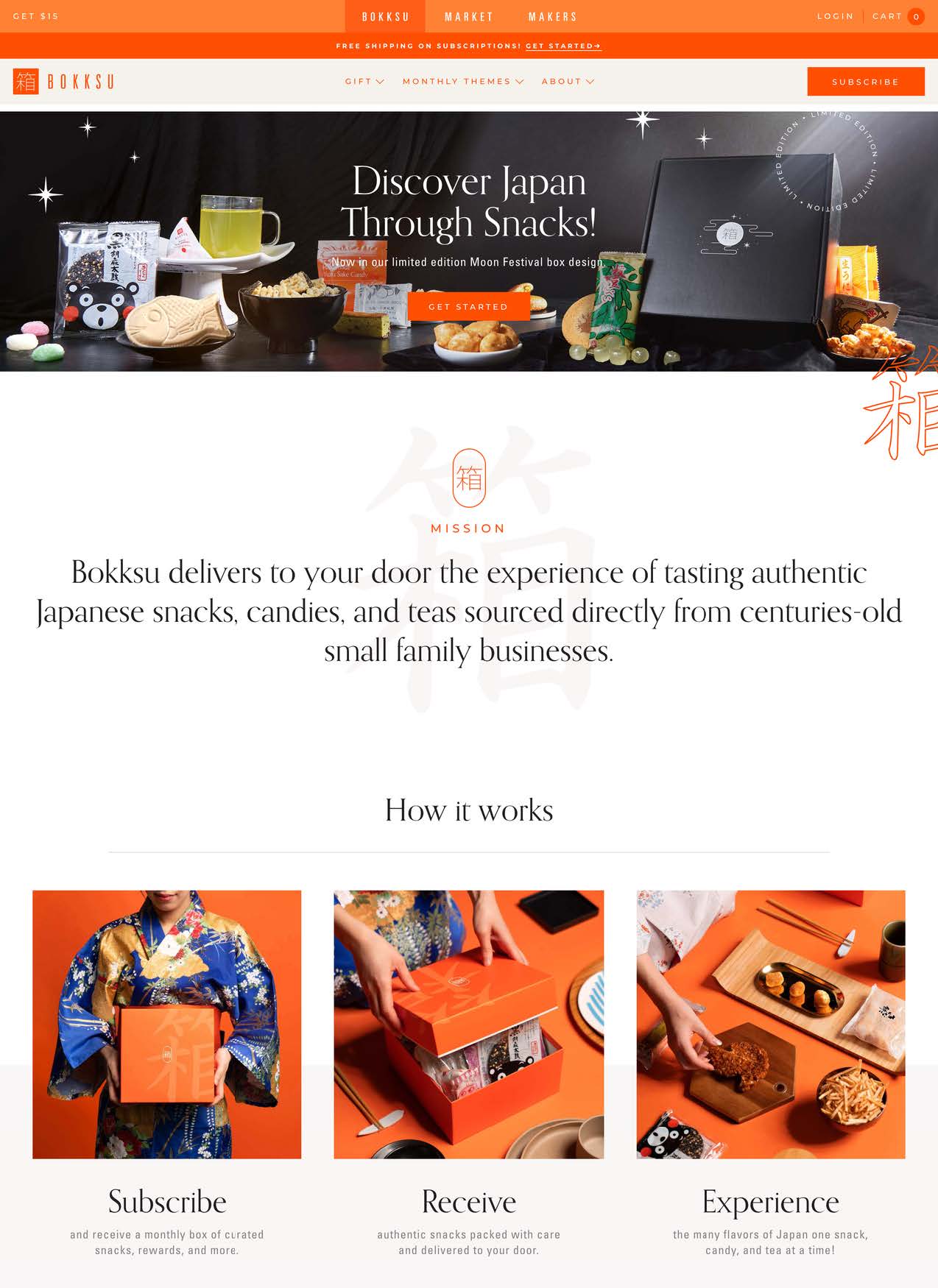
Bokksu is a great example of a single product store with strong branding and a compelling mission.
You’ll see their branded color orange throughout their website—in their photo backgrounds, their main navigation bar, their text, and all of their buttons. This consistency creates a memorable experience that encourages viewers to associate the color orange with their brand.
Their mission, displayed on their homepage, states they send snacks from “centuries-old, small family businesses.”
Bokksu subscribers are probably lovers of Japanese culture, and with their mission, Bokksu is actually saying, “If you become a Bokksu subscriber, you’re helping to keep the Japanese snack culture alive.”
2. ReduxBuds: Earbuds for a better audio experience
ReduxBuds sells noise-canceling, true wireless earbuds that make music “the soundtrack of your life.”
Their one product Shopify store works well because of its simple user experience (UX) and creative use of icons.
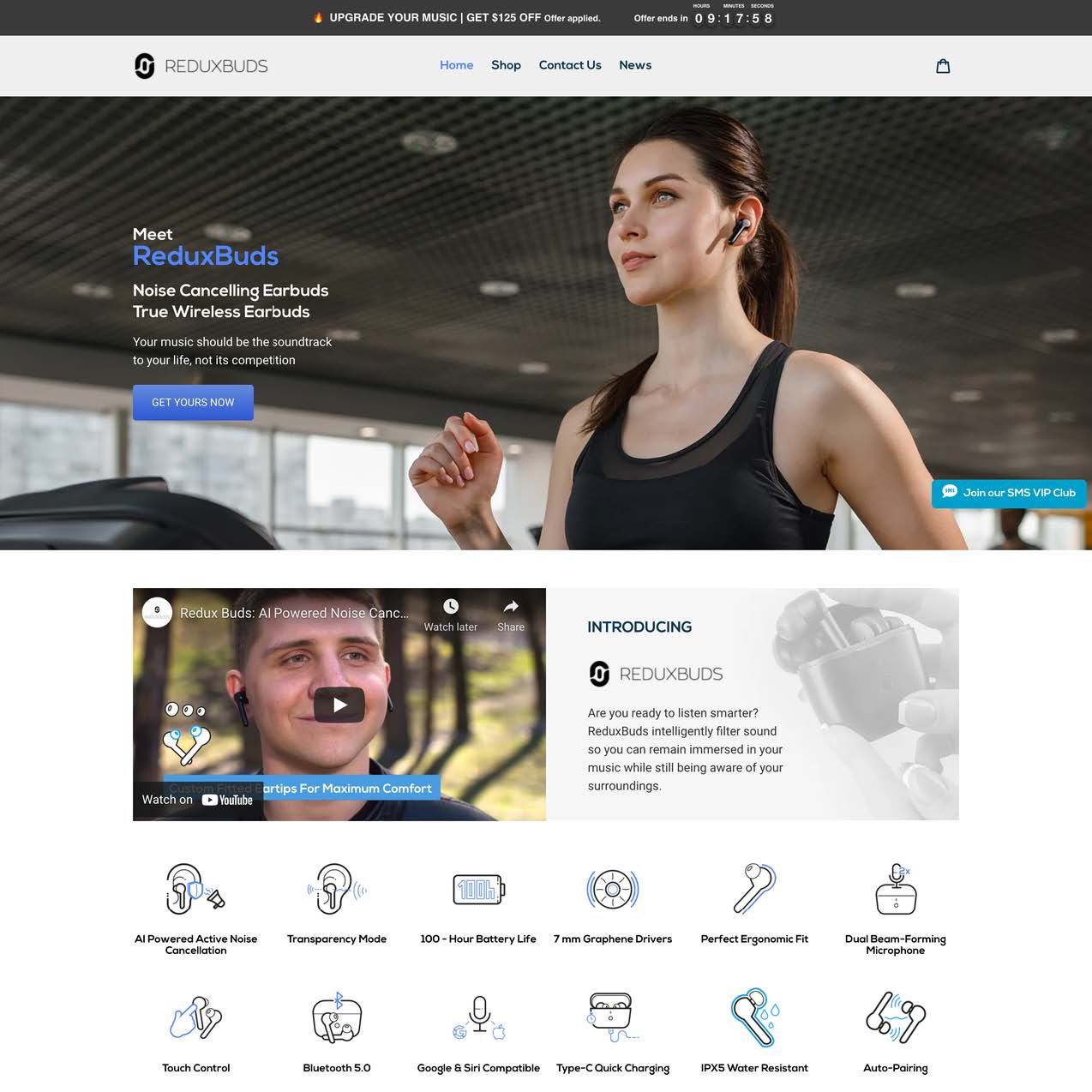
While their branding and colors aren’t as eye-catching as Bokksu’s, ReduxBuds have a simpler UX that offers multiple routes to the product page.
Right at the top, their navigation bar has a shop button that brings you to their single product: the ReduxBuds.
Scrolling through the homepage, you’ll find seven more buttons with different copy—“Get Yours Now,” “Shop Now,” and “Get ReduxBuds”—that lead to the same page.
As potential customers scroll through the homepage, reading the awesome ReduxBuds features, they always have easy access to a button that will bring them to the product page.
They also use icons highlighting the features that make ReduxBuds unique compared to other wireless earbuds on the market.
Images are more memorable and convey a stronger message, so ReduxBuds’s smart implementation of icons to accompany text makes their otherwise-nondescript homepage more memorable.
3. Aurora: Weighted blankets for better sleep
Aurora sells weighted blankets that help their customers sleep better.
This Shopify store is another great example of a one product brand because of their smart, strategic use of photos, videos, and text.
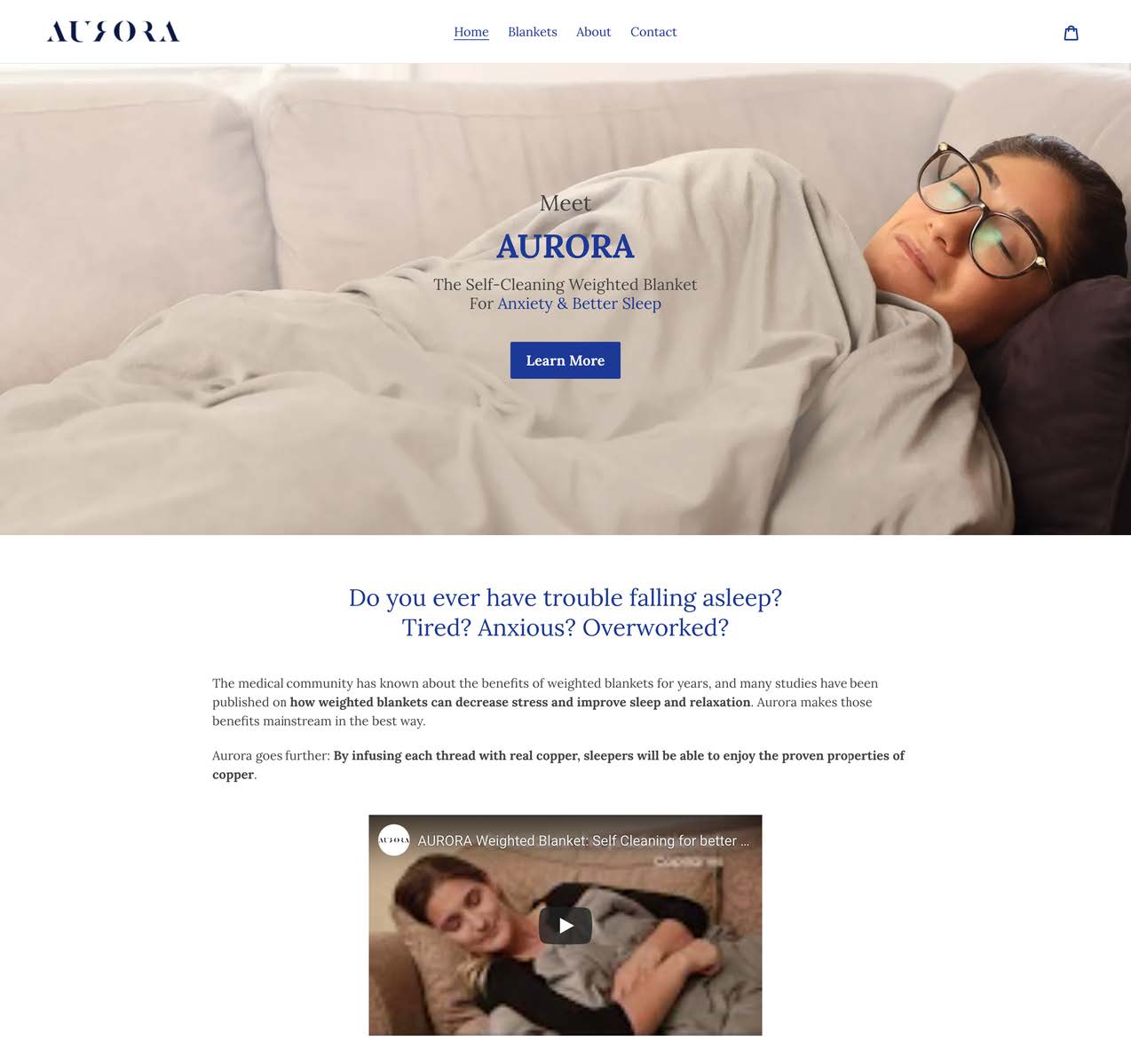
Across their homepage, Aurora has still photos, videos, and moving gifs that show different people sleeping and relaxing.
Their main goal is to tell site visitors that Aurora’s weighted blankets will help them fall asleep, no matter who or where they are.
Like ReduxBuds, Aurora also employs icons to showcase the benefits of their product, as well as simple but clear language to explain why Aurora is the top choice for people who want more restful sleep.
The difference is, despite being a much longer page compared to ReduxBuds, the weighted blanket seller’s homepage only has five buttons that lead to their product page.
While that’s not a major problem, giving your potential customers easy access to your product page significantly improves the user experience and reminds them to complete their purchase.
One product Shopify store FAQs
How do I choose the right product?
Selecting the right product is like finding the perfect dance partner. It must align with your brand, have a strong market demand, and be something you’re passionate about. If it doesn’t twirl you around the dance floor, it’s not the one.
What are the challenges of running a one product store?
Challenges include dependency on a single product, market saturation, and potential difficulties in scaling. It’s not all sunshine and rainbows, but with the right strategies, you can weather any storm.
Why should I consider starting a one product store?
By focusing on one product, you can create a highly targeted and cohesive brand image. It’s a laser-focused approach that can lead to higher conversion rates.
Use a one product Shopify store to build your ecommerce empire
Whether you’re just starting out or want to pivot from traditional ecommerce sites, a one product Shopify store is an excellent idea if you have that one, compelling product people will want to buy.
Single product pages are easy to build and maintain and even easier to gain profit. And, if you market to the right audience, more often than not, they’ll click that “Buy Now” button.
Head over to the Shogun Page Builder when you’re ready to construct and customize a Shopify store that’s memorable and easy to navigate.
#cta-visual-pb#<cta-title>Create a truly custom store for your great product idea<cta-title>You can build the store your product deserves with Shogun Page Builder.Start building for free

Rachel Go
Rachel is a remote marketing manager with a background in building scalable content engines. She creates content that wins customers for B2B ecommerce companies like MyFBAPrep, Shogun, and more. In the past, she has scaled organic acquisition efforts for companies like Deliverr and Skubana.



